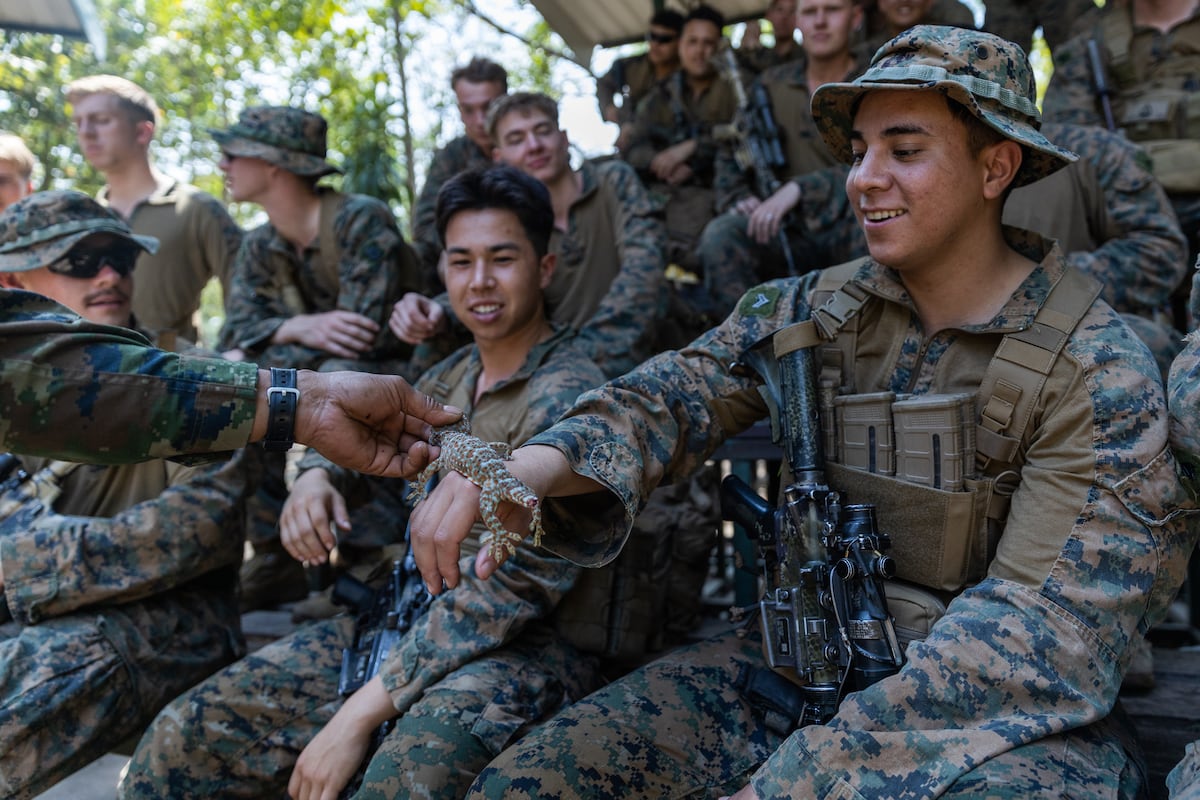World
Troops Honor Reptiles with Call Signs and Symbols

On National Reptile Awareness Day, observed on October 17, military personnel reflect on the significance of reptiles in their ranks. The U.S. military employs a range of reptilian mascots and call signs, from cobras to alligators, as symbols embodying the qualities of patience, precision, and power. This tradition is deeply ingrained in military culture, influencing unit identities and operational strategies across various branches.
Reptilian Symbolism in Military Culture
Reptiles resonate with service members due to their primal toughness. A cobra strikes without warning, while an alligator remains still until the opportune moment. This instinct mirrors the training of military personnel, who often must exercise similar control and discipline. For example, a sniper can hold their breath for hours, just as an alligator may wait underwater to ambush its prey. Both rely on timing rather than chaos, a principle that is essential in military operations.
The historical significance of reptiles in military contexts is highlighted by the U.S. 158th Infantry Regiment, which earned the nickname “Bushmasters” during World War II after encounters with the venomous snake in Panama and the Pacific. The name was not merely for flair; it represented survival and resilience. Today, the Bushmaster remains an integral part of the regiment’s heritage, depicted on its insignia.
Reptiles thrive in the environments where American forces have fought for over a century—deserts, swamps, and jungles. This shared toughness has made them fitting emblems. In Iraq and Afghanistan, Marines in amphibious assault units embraced the nickname “Gators,” reflecting both their vehicles and their versatility, akin to the adaptability of the animal they represent.
Practical Applications of Reptilian Nicknames
The 75th Field Artillery Regiment officially adopted reptilian imagery within its insignia in 1923, featuring a gold lizard on a red shield. This design pays homage to the regiment’s roots in Alabama, previously known as the “Lizard State.” The lizard symbolizes quickness and survival, characteristics that define the artillerymen who serve under this banner.
Reptilian call signs serve practical purposes as well. Short names like “Cobra One” or “Viper Six” are easily recognizable on radio channels, cutting through static and confusion. Their sharp, aggressive sounds convey decisiveness, and over time, these names become woven into the fabric of a unit’s history, spoken with pride by soldiers who may never have met.
During the Vietnam War, the connection between reptiles and aviation solidified with the introduction of the Bell AH-1 “Cobra” helicopter in 1967. The aircraft’s sleek design and lethal capabilities matched the symbolism of the snake, reinforcing its status as a representation of American air dominance. Today, the AH-1Z “Viper,” a modern upgrade, continues this tradition, embodying the same qualities in combat.
Reptilian imagery extends to military heraldry as well. The 3rd Armored Cavalry Regiment historically used the motto, “Brave Rifles, Scales of the Dragon,” merging reptilian symbolism with mythology to convey unity and strength. The Marine Corps’ Amphibious Assault Schools in California are informally known as “the Gator School,” a nod to their amphibious heritage and their involvement in World War II landings.
The military’s use of reptilian symbols dates back thousands of years, with ancient Egyptians invoking crocodiles for power and protection. This historical connection to strength and military success mirrors modern American patches and mottos, where the underlying message remains consistent: be patient, strike hard, and survive.
Enduring Legacy of Reptilian Symbolism
The term “cold-blooded” has evolved within military vernacular to describe operating without emotion, signifying the ability to carry out missions despite fear, fatigue, or doubt. This reflects the focused discipline exemplified by a gator before it snaps its jaws.
When soldiers don patches adorned with reptilian motifs or bear call signs like “Cobra One,” they embody a legacy of storytelling and tradition that spans decades. Reptiles, having survived longer than nearly any other species, symbolize adaptability, endurance, and dominance—qualities that resonate with service members trained to exemplify the same traits.
From the jungles of the Pacific to the deserts of Iraq, the alligator and cobra remain among the military’s most enduring symbols. They represent readiness, resilience, and survival. For a young soldier earning a patch marked by a gator’s jaw or a coiled snake, it signifies joining a lineage steeped in decades of service and tradition.
-

 Science2 weeks ago
Science2 weeks agoIROS 2025 to Showcase Cutting-Edge Robotics Innovations in China
-

 Politics2 weeks ago
Politics2 weeks agoJudge Considers Dismissal of Chelsea Housing Case Citing AI Flaws
-

 World2 weeks ago
World2 weeks agoBravo Company Veterans Honored with Bronze Medals After 56 Years
-

 Top Stories2 weeks ago
Top Stories2 weeks agoIndonesia Suspends 27,000 Bank Accounts in Online Gambling Crackdown
-

 Lifestyle2 weeks ago
Lifestyle2 weeks agoStone Island’s Logo Worn by Extremists Sparks Brand Dilemma
-

 Health2 weeks ago
Health2 weeks agoStartup Liberate Bio Secures $31 Million for Next-Gen Therapies
-

 Sports2 weeks ago
Sports2 weeks agoMel Kiper Jr. Reveals Top 25 Prospects for 2026 NFL Draft
-

 Health2 weeks ago
Health2 weeks agoTop Hyaluronic Acid Serums for Radiant Skin in 2025
-

 World2 weeks ago
World2 weeks agoHoneywell Predicts Record Demand for Business Jets Over Next Decade
-

 Politics2 weeks ago
Politics2 weeks agoNew Jersey Voters Urged to Register Ahead of November Election
-

 Lifestyle2 weeks ago
Lifestyle2 weeks agoMary Morgan Jackson Crowned Little Miss National Peanut Festival 2025
-

 Sports2 weeks ago
Sports2 weeks agoYamamoto’s Mastery Leads Dodgers to 5-1 Victory in NLCS Game 2









